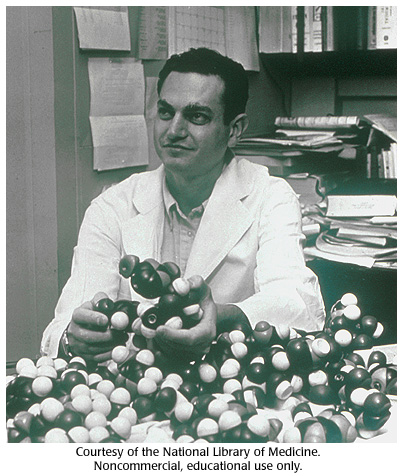Gallery 22: Marshall Nirenberg, 1960

Marshall Nirenberg in his office at the NIH, 1960.
Marshall Nirenberg, NIH
- ID: 16497
- Source: DNALC.DNAFTB
Related Content
16498. Gallery 22: Marshall Nirenberg, 1999
Marshall Nirenberg at the NIH, 1999. He is holding one of the original charts with 'code-cracking' data.
15355. Making triplet codons, Marshall Nirenberg
Marshall Nirenberg talks about the contributions of Maxine Singer, Marianne Grunberg-Monago and Phil Leder.
16031. Marshall Nirenberg, 1961
DNA words are three letters long
15346. Exploring science, Marshall Nirenberg
Early in his scientific career, Marshall Nirenberg had to decide what project to pursue. Marshall Nirenberg talks about his decision to become a "code-breaker."
16496. Gallery 22: Marshall Nirenberg at the White House.
Marshall Nirenberg at the White House explaining the genetic code to President Lyndon Johnson.
16511. Biography 22: Marshall Warren Nirenberg (1927- )
Marshall Nirenberg, Har Gobind Khorana, and Robert Holley shared the 1968 Nobel Prize for Physiology and Medicine. Nirenberg and Khorana cracked the genetic code. Holley sequenced and deduced the structure of the first tRNA molecule.
15696. Marshall Nirenberg
Marshall Nirenberg, National Institute of Health, 1960.
16495. Gallery 22: Marshall Nirenberg, B. P. Doctor, C. T. Caskey, 1966
1966 Cold Spring Harbor Symposium on protein synthesis. (L-R) Marshall Nirenberg, B. P. Doctor, C. T. Caskey.
15882. Breaking the code
Marshall Nirenberg and Heinrich Matthaei used poly-U mRNA in a cell-free system to make a polyphenylalanine protein chain. This showed that UUU must be the code that specifies the amino acid phenylalanine.
16504. Video 22: Marshall Nirenberg, clip 1
Explaining the experiment to determine the RNA able to direct the synthesis of proteins.












